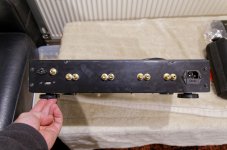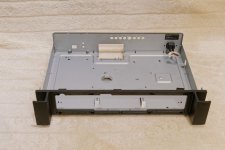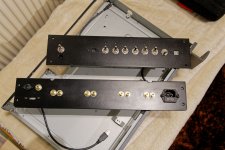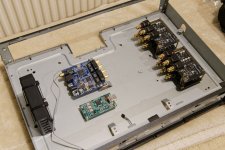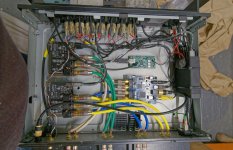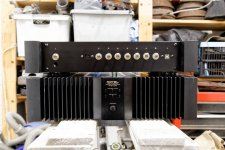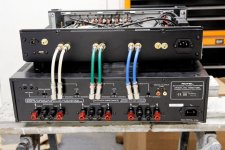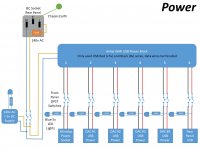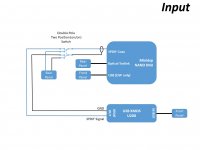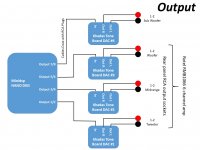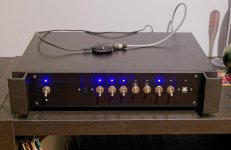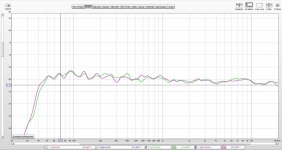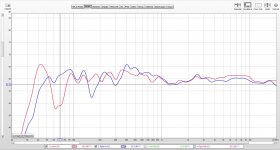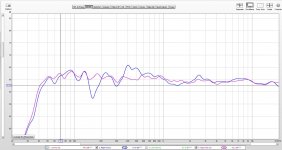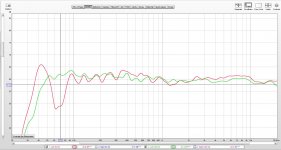Thought I'd share my DSP project just in case it is of use to anyone. This will initially be used to merge my active monitors and twin subs and sort out room EQ, but when I get some time I plan on using it for some three way speakers.
Pictures below.
Chassis - I have Rotel RMB1066 6 channel power amps (x2) so wanted something to match (ish) so bought a "for spares" Rotel RDV1060. This is really nice as you can remove the front fascia, tap some exiting holes, add a plate of aluminium and make it look nice. Rear is similar, just chop out the back and add a plate.
DSP - I only have digital sources so got a Minidsp Nanodigi
miniDSP Kits : nanoDIGI 2x8 K
Dacs (x4) - Khadas Tone Boards
Tone Board: Hi-Res Audio Board Designed for Music Fanatic.
USB input - the minidsp does not take usb streaming so bought an ebay XMOS208 input board that had a spdif output all ready to solder
U208 XMOS USB Digital Interface DAC Decoder Module Support for PCM DSD New | eBay
Powersupply - Anker 6 port USB 60W charger - measurements here - Test of Anker 60W 6-port A2123
Anker PowerPort 60 W 6-Port Family-Sized Desktop USB: Amazon.co.uk: Electronics
Complications - I wanted to add the following function which have complicated it a bit -
Case done, front and rear panels done and painted in satin black, all switched etc. and main boards mounted. Power connected, coax from DSP to DACs done. Tested Power, DAC and USB - all work fine.
Still to do -
Wire DACs to rear panel
Find a power fuse to fit (seems to be smaller, maybe european?)
Add power indicators
Download and istall Minidsp software and check DSP out.
Ideally I will remake the front and panels using laser cutting but hand made is fine for now.
Anyway, there's my little project, all comments welcome (and no, tidy wiring is not my strong point).
Pictures below.
Chassis - I have Rotel RMB1066 6 channel power amps (x2) so wanted something to match (ish) so bought a "for spares" Rotel RDV1060. This is really nice as you can remove the front fascia, tap some exiting holes, add a plate of aluminium and make it look nice. Rear is similar, just chop out the back and add a plate.
DSP - I only have digital sources so got a Minidsp Nanodigi
miniDSP Kits : nanoDIGI 2x8 K
Dacs (x4) - Khadas Tone Boards
Tone Board: Hi-Res Audio Board Designed for Music Fanatic.
USB input - the minidsp does not take usb streaming so bought an ebay XMOS208 input board that had a spdif output all ready to solder
U208 XMOS USB Digital Interface DAC Decoder Module Support for PCM DSD New | eBay
Powersupply - Anker 6 port USB 60W charger - measurements here - Test of Anker 60W 6-port A2123
Anker PowerPort 60 W 6-Port Family-Sized Desktop USB: Amazon.co.uk: Electronics
Complications - I wanted to add the following function which have complicated it a bit -
- Rear IEC three pin fused power socket and Front master switch to Anker PS.
- Individually turn the DSP and DACs on/off.
- Switch between a rear COAX SPDIF and the USB SPDIF.
- Rear Toslink
- Space the rear analogue output sockets the same as the RMB1066
- Use the final Anker port for a rear USB power socket (for powering my Chrome Cast Audio).
- Power lights for each item (combination of LED bulbs and fibre optic light pipes).
- Re-route the Minidsp IR sensor to the front panel.
- Front usb port for DSP programming and front port for USB streaming
Case done, front and rear panels done and painted in satin black, all switched etc. and main boards mounted. Power connected, coax from DSP to DACs done. Tested Power, DAC and USB - all work fine.
Still to do -
Wire DACs to rear panel
Find a power fuse to fit (seems to be smaller, maybe european?)
Add power indicators
Download and istall Minidsp software and check DSP out.
Ideally I will remake the front and panels using laser cutting but hand made is fine for now.
Anyway, there's my little project, all comments welcome (and no, tidy wiring is not my strong point).
Attachments
Last edited:
Quick update
Finished the wiring and have added LED light to each of the power circuits including the mains power (small 240vac>5v DC power supply to driver the LED). Also made up some cable to mate it to the RMB1066.
Waiting for the final piece (fuse for mains power), the can start to play with the DSP.
Pics attached (apologies for the quality, garage is quite dark).
All comments welcome.
Finished the wiring and have added LED light to each of the power circuits including the mains power (small 240vac>5v DC power supply to driver the LED). Also made up some cable to mate it to the RMB1066.
Waiting for the final piece (fuse for mains power), the can start to play with the DSP.
Pics attached (apologies for the quality, garage is quite dark).
All comments welcome.
Attachments
Thanks for the comment.
Toslink connector here - Optical TOSlink Wall Faceplate Panel Mount Socket to Socket Adapter 5055383457458 | eBay
Toslink connector here - Optical TOSlink Wall Faceplate Panel Mount Socket to Socket Adapter 5055383457458 | eBay
As a curiosity, will you be using REW to measure the speakers? After reading some of the miniDSP forum, it seems like miniDSP softwares are designed to work with REW software.
I've read that some people had problem to import the .FRD file into the miniDSP plug-in. But if you're using REW, then it won't be a problem.
I've read that some people had problem to import the .FRD file into the miniDSP plug-in. But if you're using REW, then it won't be a problem.
Ugg10,
Can you quickly draw out a SCHEMATIC diagram on how you interconnect all the different parts so that the viewers here can have a good understanding of what you want to how you achieve your objectives?
An explanation of the schematic would also help. Thanks.
Can you quickly draw out a SCHEMATIC diagram on how you interconnect all the different parts so that the viewers here can have a good understanding of what you want to how you achieve your objectives?
An explanation of the schematic would also help. Thanks.
Thanks for the comments.
I have downloaded REW and had a quick play so will probably stick with that initially.
I have started a schematic but it gets very busy so will probably split it into power, input and output pics. Won’t be able to do this until next weekend though. Sorry.
I have downloaded REW and had a quick play so will probably stick with that initially.
I have started a schematic but it gets very busy so will probably split it into power, input and output pics. Won’t be able to do this until next weekend though. Sorry.
I have a good understanding of what each component does, it depends on what you want to achieve in the end that matters, the weekend for completion is fine, a brief description of the schematic is sufficient.
My aim was for a flexible DSP / crossover that I could initially use with a pair of active speakers and two subwoofer (and sort out room EQ) but then could be used with the RM1066 to drive some DIY active 3 way speakers (and have capacity to add two subwoofers if required).
I also only have digital sources so did not need the analogue inputs otherwise a minidsp 4x10HD would have done the job. But the Nanodigi does not have a USB streaming input so I added that as an option switched with the Coax SPDIF input. The aim was to keep the signal in the digital domain as long as possible.
Finally, wanted a fairly simple build so went with pretty much off the shelf items and just wired them up.
So it ended up with -
Inputs - USB switchable (front) with COAX SPDIF (Rear) + Optical Toslink (Rear)
DSP - Minidsp Nanodigi with front usb programming port
DACs - 4 x Khadas Tone Boards
Additional - mains power switch on the front with LED, Minidsp / DACs / Rear USB power on separate power switches with LED.
Hope this helps.
I also only have digital sources so did not need the analogue inputs otherwise a minidsp 4x10HD would have done the job. But the Nanodigi does not have a USB streaming input so I added that as an option switched with the Coax SPDIF input. The aim was to keep the signal in the digital domain as long as possible.
Finally, wanted a fairly simple build so went with pretty much off the shelf items and just wired them up.
So it ended up with -
Inputs - USB switchable (front) with COAX SPDIF (Rear) + Optical Toslink (Rear)
DSP - Minidsp Nanodigi with front usb programming port
DACs - 4 x Khadas Tone Boards
Additional - mains power switch on the front with LED, Minidsp / DACs / Rear USB power on separate power switches with LED.
Hope this helps.
Last edited:
Managed to get some time tonight to finish this off.
Attached are the circuit schematics - one for power, one for input and one for output. It was all too messy putting it on one. Hopefully you can follow this and match it up to the photos.
Any questions please ask away.
I'll post some more thought once I have had time to play with the settings (may be a few weeks though, sorry).
Attached are the circuit schematics - one for power, one for input and one for output. It was all too messy putting it on one. Hopefully you can follow this and match it up to the photos.
Any questions please ask away.
I'll post some more thought once I have had time to play with the settings (may be a few weeks though, sorry).
Attachments
Thanks for a brief explanation and schematic diagrams, seem fine with me like they say as clear as mud.
I2S Input options - Tone - Khadas Community
Above link shows pin in/out for the 30 pin connector, looks like it has a master clock input if that is what you need. Load of info on the Khadas site/forum.
New version in the pipeline which sorts out the ess hump.
If you have a little extra cash then the Soncoz laqxd1 looks very interesting, but twice the price of the Khadas. This is from the same designer as the Khadas, if they produce an oem Board it would be very tempting.
LA-QXD1 High-fidelity DAC
Above link shows pin in/out for the 30 pin connector, looks like it has a master clock input if that is what you need. Load of info on the Khadas site/forum.
New version in the pipeline which sorts out the ess hump.
If you have a little extra cash then the Soncoz laqxd1 looks very interesting, but twice the price of the Khadas. This is from the same designer as the Khadas, if they produce an oem Board it would be very tempting.
LA-QXD1 High-fidelity DAC
I think the bottle neck is probably:
1. The DAC stage
2. And the amp output.
One could eliminate the DAC completely by using a class D amp that takes the digital input directly.
But anyway, I look forward to your design finished product.
1. The DAC stage
2. And the amp output.
One could eliminate the DAC completely by using a class D amp that takes the digital input directly.
But anyway, I look forward to your design finished product.
I think the bottle neck is probably:
1. The DAC stage
2. And the amp output.
One could eliminate the DAC completely by using a class D amp that takes the digital input directly.
But anyway, I look forward to your design finished product.
Thanks for the comment, interesting. Can you give an example of how the “no dac class D amp” would work? Being a bear of little brain I can’t get my head around how the digital signal from the dsp can drive a speaker without a dac in the chain somewhere? From what I have read class D amps still need an analogue input signal that it can amplify, the D does not stand for digital it is just a letter that differentiates it from different amplifier topologies I.e. class A,B,G etc. However I may be totally wrong.
Please can you please educate me so I can understand.
Thanks for the comment, interesting. Can you give an example of how the “no dac class D amp” would work? Being a bear of little brain I can’t get my head around how the digital signal from the dsp can drive a speaker without a dac in the chain somewhere? From what I have read class D amps still need an analogue input signal that it can amplify, the D does not stand for digital it is just a letter that differentiates it from different amplifier topologies I.e. class A,B,G etc. However I may be totally wrong.
Please can you please educate me so I can understand.
Here are some examples of a SPDIF input class D amp:
HiFime UDP80 USB and SPDIF True Digital Power Amplifier
Amazon.com: 80 Watts Mini Stereo Amplifier with Optical SPDIF Coaxial Input: Home Audio & Theater
Or you could Google "SPDIF class D amp".
I guess you could look in the web, but basically a class D amp is almost like a DAC in which the last stage uses a low pass filter to filter out the sample and hold. In the case of class D, the output is a PWM signal.
Theoretically, a class D amp does not require an analog input at all. It can take a SPDIF signal and convert it to a PWM signal and a low pass filter at the output.
Last edited:
Another update -
Finally got the fuse for the power socket (odd 20mm size) and have been playing with it today.
All works very well and learned REW and the Minidsp software quite quickly (well enough to set a crossover, take measurements and do a bit of EQ).
Using it at the moment with my Mackie HR824 active speakers and two Wharfedale SW150 subs placed under the speakers so in stereo. Therefore only using 4 channels.
Below are a few pics,
1) finished with lights on
2) REW before and after graphs for left and right channels
The sound comparing with and without room eq and a bit of profiling is night and day (had the two versions set up on Source 1 and 2 then volume matched them with pink noise so could compare). With Eq it is clearer, cleaner and has a very dynamic bass plus I think soundstage is better. Happy Chappy!
Finally got the fuse for the power socket (odd 20mm size) and have been playing with it today.
All works very well and learned REW and the Minidsp software quite quickly (well enough to set a crossover, take measurements and do a bit of EQ).
Using it at the moment with my Mackie HR824 active speakers and two Wharfedale SW150 subs placed under the speakers so in stereo. Therefore only using 4 channels.
Below are a few pics,
1) finished with lights on
2) REW before and after graphs for left and right channels
The sound comparing with and without room eq and a bit of profiling is night and day (had the two versions set up on Source 1 and 2 then volume matched them with pink noise so could compare). With Eq it is clearer, cleaner and has a very dynamic bass plus I think soundstage is better. Happy Chappy!
Attachments
I understand, counter intuitively the highest fidelity is currently obtained from DAC->analog signal -> class D amplifier. There are a few reasons for this:
1) you can use a self oscillating class D amplifier that has no clocked process limiting the PWM sampling frequency (Hypex, Purefi).
2) High end DACs are not single bit converters they use many parallel different strength current drivers that are switched in different combinations, this output design is not suitable for the output stage of a class D amplifier.
In fact if you look at the latest digital input class D parts from Ti they actually have a built in DAC and a classD amplifier instead of combining the two: http://www.ti.com/product/TAS3251
1) you can use a self oscillating class D amplifier that has no clocked process limiting the PWM sampling frequency (Hypex, Purefi).
2) High end DACs are not single bit converters they use many parallel different strength current drivers that are switched in different combinations, this output design is not suitable for the output stage of a class D amplifier.
In fact if you look at the latest digital input class D parts from Ti they actually have a built in DAC and a classD amplifier instead of combining the two: http://www.ti.com/product/TAS3251
- Home
- Loudspeakers
- Multi-Way
- DSP Crossover project

